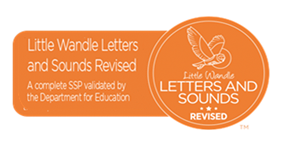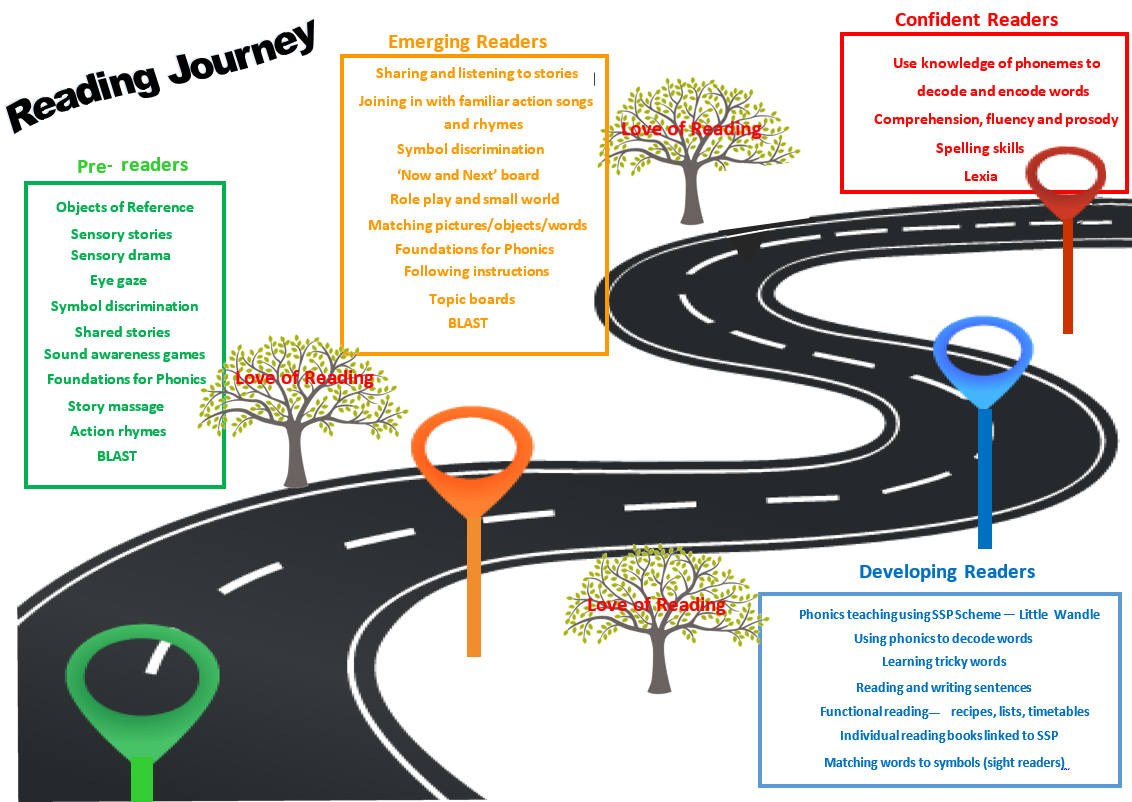Learning to read

Reading at Priory Woods School
At Priory Woods School, we actively promote the development of reading skills through a positive reading culture, embedded throughout the school. We recognise that learning to read is complex and involves a wide range of skills: visual, auditory, language and cognition. So teaching needs to have a variety of different aspects and approaches, taking into account children's individual strengths, weaknesses, needs, knowledge and skills. A pre-requisite to developing the ability to decode and recognise words is the understanding of word meaning and language comprehension.
We positively encourage the love of reading throughout school to ensure that children can make sense of the things that they encounter from books. Many opportunities are created for pupils to become familiar with stories, rhymes and songs through repetition and experiences, encouraging engagement, enjoyment and familiarity of language and vocabulary.
- We read to the children every day, from a wide range of books carefully chosen to match needs and interests and also those that open windows into other worlds and cultures.
- Every class, where appropriate, has a reading corner where children can choose to read or talk about a wide range of texts.
- Children have access to our well-stocked library where they can choose a book to take home to share with their families.
- Stories are shared and explored through, drama, dance, art and music across all curriculum pathways.
Phonics
We teach our children to read through a systematic synthetic phonics programme called Little Wandle Letters and Sounds Revised.
Early Reading Policy
We start teaching phonics once a child meets the pre key stage standards for English assessment.
Children not at Standard 1 do not need phonics instruction and will follow Foundations for Phonics activities to develop phonemic awareness and develop listening skills.
|
Standard 1 Language Comprehension In a familiar story/rhyme, the pupil can, when being read to by an adult (one-to-one or in a small group): • indicate correctly pictures of characters and objects in response to questions such as ‘Where is (the)…?’ • show anticipation about what is going to happen (e.g. by turning the page) • join in with some actions or repeat some words, rhymes and phrases when prompted. |
It is essential that our approach to teaching phonics is accessible to all learners regardless of learning difficulties. As a result, they will be equipped with the tools to tackle unfamiliar vocabulary and have the crucial skills needed to read independently.
Children not at Standard 1 do not need phonics instruction and will follow ‘Foundations for Phonics’ activities to develop phonemic awareness and develop listening skills. These children will be working within the Engagement Model.
Foundations for phonics
Activities that develop focused listening and attention
Oral blending
Oral segmenting is the process of breaking down words into phonemes (the smallest units of sound). Oral blending is the process of saying these sounds then blending them together into a word. It helps children identify and hear phonemes in words and blend them together to read a word. It is important that children have plenty of experience of listening to adults modelling oral blending and joining in with oral blending activities before they are introduced to grapheme–phoneme correspondence. This ensures they are ‘tuned into’ sounds when they begin Phase 2. In Foundations for phonics we are focusing on just the phonemes. Just the sounds.
Tuning into sounds
To enable children to begin to distinguish the initial sound in words, they need exposure to a range of games that develop this. These opportunities should be short games that are age- appropriate to ensure children are engaged in them. Games that involve children’s names or animals, or are part of an alliterative story or poem, are good ways to develop this skill.
The above provision will ensure children are in the best possible place to begin Phase 2 phonics learning.

Little Wandle Phases 2-5
Children will learn phonics through ‘Little Wandle Letters and Sounds Revised’. The programme includes weekly lesson plans and planned assessment materials to help achieve a constant pace of learning and is designed for the teaching of all children in a mainstream setting. We are following the SEND version of the programme, which has been developed to be used with a graduated approach to teach children to learn to read in small steps that provide the right amount of challenge. It provides pathways for pupils who may need very specific adaptations to the teaching steps because they have complex needs, and has been developed with the advice from special schools across the country.
Fluent Readers
Students that have successfully completed the Little Wandle programme and have passed the placement assessment are considered fluent readers and will not access the phonics programme. They will follow the ‘Lexia Reading Programme’. Reading for these students will focus on shared understanding, comprehension, discussion and answering questions.
Sight Reading
For those children with a hearing impairment, sight recognition appears to be the best approach to learning to read. They will use a combination of whole word recognition, symbols and BSL (British Sign Language).







